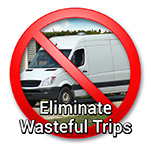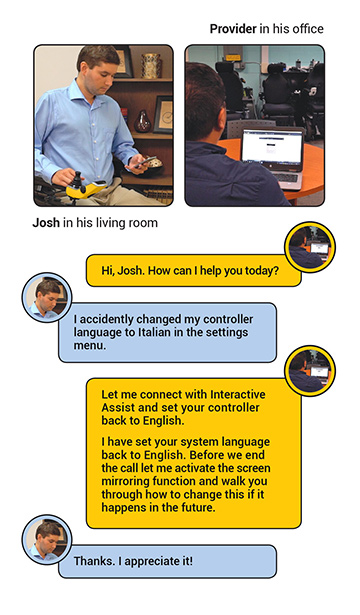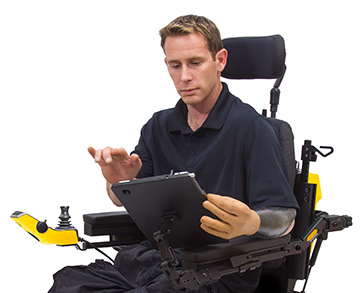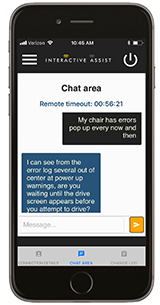Quantum Electronics


Get Interactive Assist!
Reduce service visits with Interactive Assist, a new diagnostic app from Quantum Rehab that provides a direct, real-time connection from a power chair’s electronics to a provider’s programming station. The connection provides the technician with full system and diagnostics information along with tools, such as a real-time mirror image of the power chair’s electronics display, to aid in eliminating wasteful trips.
Using Interactive Assist, a provider may be able to quickly resolve:
- Battery management issues
- Charging problems
- Motor problems
- Basic programming
- Viewing error code history
- Troubleshooting
- Remote connection to programming infrared
- Adding photos in photo album
- Dealer-to-dealer connection
- Real-time monitoring of problems


Fault codes Interactive Assist can resolve remotely...
Code 14 - "Proportional Input Device Not Connected"
Occurs when a programmed device is missing at startup.
Provider can connect via end user and instruct them on how to select the correct proportional input device via AUX menu if another input device exists.
Code 28 - "Main Relay Warning" possibly under voltage
Provider can connect via end user, look at the charging history and determine if the end user is undercharging the batteries. If this is the case, they can re-educate the end user on proper charging habits.
Code 45 - "Input Device Not Present"
Occurs when a programmed device is missing at startup.
Provider can connect via end user and instruct them on how to select the correct input device via AUX menu if another input device exists.
Fault codes Interactive Assist can identify a resolution for...
Code 15 - "Drive Motor Encoder Not Connected"
Provider can connect via end user and determine if encoders are enabled. If encoders are not enabled, a technician will need to be sent out to enable the encoders. If encoders are enabled and the fault is occurring, the provider needs to replace motors.
Code 23 - “Motor 1 Output Defect"
Code 24 - “Motor 2 Output Defect”
Provider can connect via end user, view the firmware version and determine if a firmware update is necessary.
Code 28 - "Main Relay Warning" possibly under voltage
If the charging habits are good, provider can determine if there is an issue with the batteries, charger, or a wiring harness.
Code 43 - “Motor 1 Current Measurement Out of Range"
Code 44 - “Motor 2 Current Measurement Out of Range”
Provider can connect via end user and determine if a firmware update is necessary.
Code 49 - "DMS Fault"
Provider can connect via end user and monitor to see if an input device is out of center without being deflected. If an input device shows out of center, that device needs to be replaced. If an input device is not out of center they can check to see if they have the latest firmware pack. If both input device and firmware check out, a technician will need to be sent out to troubleshoot.
Code 72 - "Warning: Speed Reduction”
(Stability Control Supervision)
Provider can connect via end user and determine if the caster sensors are connected or out of calibration. If they are out of calibration, the provider will need to send a technician on site to recalibrate. If the casters are not being detected, the provider can instruct a caregiver to make sure the caster sensors are firmly connected.
Issues Interactive Assist can resolve when a technician or clinician is on-site...
ISSUE: Technician/clinician is using a handheld programmer. Consumer says they would like to operate iLevel® through a switch.
SOLUTION: Technician/clinician can contact Quantum® Tech Support and have remote ECON connect through dealer-to-dealer access. QTS can perform advanced programming that the handheld cannot perform.
ISSUE: Consumer says Sip-n-Puff is hard to operate.
SOLUTION: Technician/clinician can contact Quantum® Tech Support and have remote ECON connect with dealer-to-dealer access. QTS can check pressure and make adjustments that on-site technician/clinician may not be familiar and/or comfortable with. NOTE: Advanced programming of ALL drive control devices can be performed with IA.
Issues Interactive Assist can resolve remotely...
ISSUE: Consumer reports they are in drive lockout.
SOLUTION: Provider can connect via end user, troubleshoot the AAM using the monitor feature and make sure that the consumer's
tilt and/or recline angle isn't too great that it would cause a drive lockout.
ISSUE: Consumer heard they can control their computer through the input device.
SOLUTION: Provider can connect via end user and set up mouse clicks for the consumer. Consumer can review Quantum Rehab's
Bluetooth® videos and connect the electronics to their computer on their own.
ISSUE: Consumer is having trouble navigating the Q-Logic 3 menu.
SOLUTION: Provider can connect via end user, mirror their screen on the ECON-W programming station and walk the consumer
through what they need to do.
ISSUE: Consumer reports they are seeing error codes.
SOLUTION: Provider can connect via end user, access the client’s fault history, see what errors have been occurring and troubleshoot
from there. This issue could be as simple as a loose cable. Technician can direct caregiver to check connections are secure.
ISSUE: Consumer heard that Q-Logic 3 can control IR devices.
SOLUTION: Provider can connect via end user and build menu trees for IR. Consumer or caregiver can then use the remote control to set the codes.
ISSUE: Consumer has been using Bluetooth®, accessing the clicks through a switch. They want to access the clicks through the joystick.
SOLUTION: Provider can connect via end user and update the access method.
ISSUE: Consumer reports the chair won't drive.
SOLUTION: Provider can access via end user and verify motors are properly engaged. If disengaged, technician can direct caregiver
how to engage the motor(s).
Issues Interactive Assist can identify a resolution for...
ISSUE: Consumer reports they are getting an error message intermittently.
SOLUTION: Provider can connect via end user to check the fault/ error log. If the issue cannot be resolved remotely the technician knows what equipment is needed to fix the issue or further test the problem.
ISSUE: Consumer reports the wheelchair is veering to right or left.
SOLUTION: Provider can connect via end user, monitor the system and see if a motor is pulling high current. This allows the technician to bring the correct parts to the consumer's home for a repair.
ISSUE: Consumer reports they cannot tilt (or recline) past a certain degree.
SOLUTION: Provider can connect via end user, see where the angle stops, review the change log, identify any changes were made and
determine if a trip is needed.



